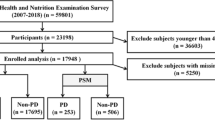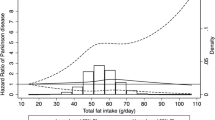Abstract
Identification of dietary and lifestyle variables associated with the development of Parkinson’s disease (PD) may offer pathogenetic clues and prevention opportunities. In a population-based prospective cohort study, 26,173 participants in the EPIC–Greece cohort had sociodemographic, anthropometric, medical, dietary and lifestyle variables ascertained at enrolment and periodically reassessed with follow-up contacts. Based on these data, subjects were screened as possible PD cases if they (1) reported either a medical diagnosis of PD or use of anti-PD drugs and (2) did not report preceding causes of secondary parkinsonism. For diagnostic validation, possible incident PD cases were assessed by a focused 3-item telephone questionnaire. Cox proportional hazards regression was used to evaluate associations between potential predictors and incident PD. The main multivariate model included gender, age, marital status, schooling years, farming occupation, smoking status, caffeinated coffee, body mass index, physical activity and energy intake. Additional models included all above variables plus one dietary item at a time. Incidence rate adjusted to the European population was 16.9 per 100,000 person-years. In multivariate models, incident PD exhibited strong positive association with consumption of milk, but not cheese or yoghurt. This finding may help narrow down the search for potential dairy product components with a facilitatory role in PD. Concerning other dietary components, inverse association was found between polyunsaturated fat intake and incident PD. Also, inverse association was found with tobacco smoking, in line with previous studies, but not with caffeine.


Similar content being viewed by others
References
Chen H, Zhang SM, Hernan MA, Willett WC, Ascherio A. Diet and Parkinson’s disease: a potential role of dairy products in men. Ann Neurol. 2002;52:793–801.
Hernan MA, Takkouche B, Caamano-Isorna F, Gestal-Otero JJ. A meta-analysis of coffee drinking, cigarette smoking, and the risk of Parkinson’s disease. Ann Neurol. 2002;52:276–84.
Alves G, Forsaa EB, Pedersen KF, Dreetz Gjerstad M, Larsen JP. Epidemiology of Parkinson’s disease. J Neurol. 2008;255(Suppl 5):18–32.
Elbaz A, Moisan F. Update in the epidemiology of Parkinson’s disease. Curr Opin Neurol. 2008;21:454–60.
Tanner CM. Advances in environmental epidemiology. Mov Disord. 2010;25(Suppl 1):S58–62.
Wirdefeldt K, Adami HO, Cole P, Trichopoulos D, Mandel J. Epidemiology and etiology of Parkinson’s disease: a review of the evidence. Eur J Epidemiol. 2011;26(Suppl 1):S1–58.
Trichopoulou A, Costacou T, Bamia C, Trichopoulos D. Adherence to a Mediterranean diet and survival in a Greek population. N Engl J Med. 2003;348:2599–608.
Bingham S, Riboli E. Diet and cancer–the European prospective investigation into cancer and nutrition. Nat Rev Cancer. 2004;4:206–15.
Riboli E, Hunt KJ, Slimani N, et al. European prospective investigation into cancer and nutrition (epic): study populations and data collection. Public Health Nutr. 2002;5:1113–24.
Gallo V, Bueno-De-Mesquita HB, Vermeulen R, et al. Smoking and risk for amyotrophic lateral sclerosis: analysis of the EPIC cohort. Ann Neurol. 2009;65:378–85.
Michaud DS, Gallo V, Schlehofer B, et al. Coffee and tea intake and risk of brain tumors in the European prospective investigation into cancer and nutrition (EPIC) cohort study. Am J Clin Nutr. 2010;92:1145–50.
Psaltopoulou T, Kyrozis A, Stathopoulos P, Trichopoulos D, Vassilopoulos D, Trichopoulou A. Diet, physical activity and cognitive impairment among elders: the EPIC-Greece cohort (European prospective investigation into cancer and nutrition). Public Health Nutr. 2008;11:1054–62.
Ainsworth BE, Haskell WL, Leon AS, et al. Compendium of physical activities: classification of energy costs of human physical activities. Med Sci Sports Exerc. 1993;25:71–80.
Trichopoulou A, Gnardellis C, Lagiou A, Benetou V, Trichopoulos D. Body mass index in relation to energy intake and expenditure among adults in Greece. Epidemiology. 2000;11:333–6.
Gnardellis C, Trichopoulou A, Katsouyanni K, Polychronopoulos E, Rimm EB, Trichopoulos D. Reproducibility and validity of an extensive semiquantitative food frequency questionnaire among Greek school teachers. Epidemiology. 1995;6:74–7.
Katsouyanni K, Rimm EB, Gnardellis C, Trichopoulos D, Polychronopoulos E, Trichopoulou A. Reproducibility and relative validity of an extensive semi-quantitative food frequency questionnaire using dietary records and biochemical markers among Greek schoolteachers. Int J Epidemiol. 1997;26(Suppl 1):S118–27.
Goldbohm RA, van ‘t Veer P, van den Brandt PA, et al. Reproducibility of a food frequency questionnaire and stability of dietary habits determined from five annually repeated measurements. Eur J Clin Nutr. 1995;49:420–9.
Willett WC, Sampson L, Browne ML, et al. The use of a self-administered questionnaire to assess diet 4 years in the past. Am J Epidemiol. 1988;127:188–99.
Trichopoulou A, Georga K, editors. Composition tables of simple and composite foods. Parisianos: Athens, Greece; 2004.
Gibb WR, Lees AJ. A comparison of clinical and pathological features of young- and old-onset Parkinson’s disease. Neurology. 1988;38:1402–6.
Van Den Eeden SK, Tanner CM, Bernstein AL, et al. Incidence of Parkinson’s disease: variation by age, gender, and race/ethnicity. Am J Epidemiol. 2003;157:1015–22.
de Lau LM, Bornebroek M, Witteman JC, Hofman A, Koudstaal PJ, Breteler MM. Dietary fatty acids and the risk of Parkinson disease: the Rotterdam study. Neurology. 2005;64:2040–5.
de Lau LM, Breteler MM. Epidemiology of Parkinson’s disease. Lancet Neurol. 2006;5:525–35.
Elbaz A, Tranchant C. Epidemiologic studies of environmental exposures in Parkinson’s disease. J Neurol Sci. 2007;262:37–44.
Shulman LM. Gender differences in Parkinson’s disease. Gend Med. 2007;4:8–18.
Taylor KS, Cook JA, Counsell CE. Heterogeneity in male to female risk for Parkinson’s disease. J Neurol Neurosurg Psychiatry. 2007;78:905–6.
Semchuk KM, Love EJ, Lee RG. Parkinson’s disease and exposure to agricultural work and pesticide chemicals. Neurology. 1992;42:1328–35.
Gorell JM, Johnson CC, Rybicki BA, Peterson EL, Richardson RJ. The risk of Parkinson’s disease with exposure to pesticides, farming, well water, and rural living. Neurology. 1998;50:1346–50.
Ascherio A, Chen H, Weisskopf MG, et al. Pesticide exposure and risk for Parkinson’s disease. Ann Neurol. 2006;60:197–203.
Rocca WA, Anderson DW, Meneghini F, et al. Occupation, education, and Parkinson’s disease: a case-control study in an Italian population. Mov Disord. 1996;11:201–6.
Seidler A, Hellenbrand W, Robra BP, et al. Possible environmental, occupational, and other etiologic factors for Parkinson’s disease: a case-control study in Germany. Neurology. 1996;46:1275–84.
Kuopio AM, Marttila RJ, Helenius H, Rinne UK. Environmental risk factors in Parkinson’s disease. Mov Disord. 1999;14:928–39.
Hellenbrand W, Seidler A, Robra BP, et al. Smoking and Parkinson’s disease: a case-control study in Germany. Int J Epidemiol. 1997;26:328–39.
Louis ED, Luchsinger JA, Tang MX, Mayeux R. Parkinsonian signs in older people: prevalence and associations with smoking and coffee. Neurology. 2003;61:24–8.
Allam MF, Campbell MJ, Hofman A, Del Castillo AS, Fernandez-Crehuet Navajas R. Smoking and Parkinson’s disease: systematic review of prospective studies. Mov Disord. 2004;19:614–21.
Morens DM, Grandinetti A, Reed D, White LR, Ross GW. Cigarette smoking and protection from Parkinson’s disease: false association or etiologic clue? Neurology. 1995;45:1041–51.
Gorell JM, Rybicki BA, Johnson CC, Peterson EL. Smoking and Parkinson’s disease: a dose-response relationship. Neurology. 1999;52:115–9.
Tanner CM, Goldman SM, Aston DA, et al. Smoking and Parkinson’s disease in twins. Neurology. 2002;58:581–8.
Thacker EL, O’Reilly EJ, Weisskopf MG, et al. Temporal relationship between cigarette smoking and risk of Parkinson disease. Neurology. 2007;68:764–8.
O’Reilly EJ, Chen H, Gardener H, Gao X, Schwarzschild MA, Ascherio A. Smoking and Parkinson’s disease: using Parental smoking as a proxy to explore causality. Am J Epidemiol. 2009;169:678–82.
Allam MF, Campbell MJ, Del Castillo AS, Fernandez-Crehuet Navajas R. Parkinson’s disease protects against smoking? Behav Neurol. 2004;15:65–71.
Evans AH, Lawrence AD, Potts J, et al. Relationship between impulsive sensation seeking traits, smoking, alcohol and caffeine intake, and Parkinson’s disease. J Neurol Neurosurg Psychiatry. 2006;77:317–21.
Benedetti MD, Bower JH, Maraganore DM, et al. Smoking, alcohol, and coffee consumption preceding Parkinson’s disease: a case-control study. Neurology. 2000;55:1350–8.
Hu G, Bidel S, Jousilahti P, Antikainen R, Tuomilehto J. Coffee and tea consumption and the risk of Parkinson’s disease. Mov Disord. 2007;22:2242–8.
Ascherio A, Zhang SM, Hernan MA, et al. Prospective study of caffeine consumption and risk of Parkinson’s disease in men and women. Ann Neurol. 2001;50:56–63.
Saaksjarvi K, Knekt P, Rissanen H, Laaksonen MA, Reunanen A, Mannisto S. Prospective study of coffee consumption and risk of Parkinson’s disease. Eur J Clin Nutr. 2008;62:908–15.
Sasco AJ, Paffenbarger RSJ, Gendre I, Wing AL. The role of physical exercise in the occurrence of Parkinson’s disease. Arch Neurol. 1992;49:360–5.
Chen H, Zhang SM, Schwarzschild MA, Hernan MA, Ascherio A. Physical activity and the risk of Parkinson disease. Neurology. 2005;64:664–9.
Thacker EL, Chen H, Patel AV, et al. Recreational physical activity and risk of Parkinson’s disease. Mov Disord. 2008;23:69–74.
Logroscino G, Sesso HD, Paffenbarger RSJ, Lee IM. Physical activity and risk of Parkinson’s disease: a prospective cohort study. J Neurol Neurosurg Psychiatry. 2006;77:1318–22.
Hamer M, Chida Y. Physical activity and risk of neurodegenerative disease: a systematic review of prospective evidence. Psychol Med. 2009;39:3–11.
Park M, Ross GW, Petrovitch H, et al. Consumption of milk and calcium in midlife and the future risk of Parkinson disease. Neurology. 2005;64:1047–51.
Chen H, O’reilly E, McCullough ML, et al. Consumption of dairy products and risk of Parkinson’s disease. Am J Epidemiol. 2007;165:998–1006.
Acknowledgments
The work was support by the Hellenic Health Foundation, the Stavros Niarchos Foundation and the Hellenic Ministry of Health and Social Solidarity. We thank Chrysa Bikou and Theodora Psaltopoulou for their help.
Dr. Dimitris Vassilopoulos is deceased. He was Professor & Chairman of the 1st Department of Neurology, University of Athens Medical School.
Conflict of interest
Authors have no financial disclosures.
Author information
Authors and Affiliations
Corresponding author
Additional information
Dimitris Vassilopoulos: Deceased.
Rights and permissions
About this article
Cite this article
Kyrozis, A., Ghika, A., Stathopoulos, P. et al. Dietary and lifestyle variables in relation to incidence of Parkinson’s disease in Greece. Eur J Epidemiol 28, 67–77 (2013). https://doi.org/10.1007/s10654-012-9760-0
Received:
Accepted:
Published:
Issue Date:
DOI: https://doi.org/10.1007/s10654-012-9760-0




